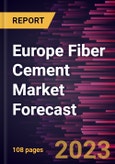The Europe fiber cement market is expected to grow from US$ 6,833.91 million in 2022 to US$ 10,571.71 million by 2028. It is estimated to grow at a CAGR of 7.5% from 2022 to 2028.
Based on type, the Europe fiber cement market is segmented into air-cured and autoclaved. The autoclaved segment held a larger share of the Europe fiber cement market in 2022.
Based on application, the Europe fiber cement market is segmented into roofing, outside siding or façade, and others. The outside siding or façade segment held the largest share of the Europe fiber cement market in 2022.
Based on end- use, the Europe fiber cement market is segmented into residential and non-residential. The non-residential segment held a larger share of the Europe fiber cement market in 2022.
Based on country, the Europe fiber cement market is segmented int o the Germany, France, Italy, the UK, Russia, and the Rest of Europe. The Rest of Europe dominated the share of the Europe fiber cement market in 2022.
Compagnie de Saint Gobain SA; Etex NV; James Hardie Industries plc; NICHIHA Corp; and Swisspearl Group AG are the leading companies operating in the Europe fiber cement market.
Surging Demand for Energy-Efficient Buildings Europe Fiber Cement Market
According to the Energy Sector Management Assistance Program, nearly one-third of global energy is consumed in residential, public, and commercial buildings for space cooling, heating, ventilating, cooking, refrigerating, lighting, water heating, and operating electric and mechanical devices. Modernizing cities in developing countries and increasing per capita income propel energy use in buildings across the world. High energy consumption in public, residential, and commercial buildings create a need for energy savings. A layer of fiber cement is applied to the building to reduce heat transfer through the walls, keeping the interior warmer in winter and cooler in summer, which makes a building energy efficient. According to the ASHRAE Fundamentals Handbook, fiber cement has an R-value of 0.15, which is better than the value of brick and stone. Many fiber cement products have a finish that reflects light. This reflection helps the building absorb less heat from the sun and keep the building's interior cooler. It reduces the need for air conditioning, saving energy and lowering energy bills. Fiber cement is often put on top of a layer of foam insulation, making the building energy efficient. This efficiency can help homeowners reduce their energy consumption and energy bills. With an increasing demand for energy-efficient homes, houses are valued higher when built with sustainable resources. All these factors drive the Europe fiber cement market.Europe Fiber Cement Market Overview
Germany, France, Italy, the UK, and Russia, are some of the main consumers within the fiber cement market in Europe. Europe's construction sector has had a consistent expansion, fueled by a rising population. Also, rapid shifts in the remodeling trends, such as remodeling for accessibility, customizations, and technological integrations, are likely to increase the business expansion. Thus, the advantages associated with fiber cement board, along with expansion in the public and private building sectors, are the primary drivers of fiber cement market growth in the area. The restoration of old buildings in countries such as Italy and Spain is propelling the development of the fiber cement market in Europe. The asbestos ban by the European Commission in 2005, led to the adoption of non-asbestos fiber cement boards and forced manufacturers to innovate eco-friendly alternatives to asbestos products. The growth of the fiber cement market has also been supported by increased government spending on infrastructure.Exhibit: Europe Fiber Cement Market Revenue and Forecast to 2028 (US$ Million)
Europe Fiber Cement Market Segmentation
The Europe fiber cement market is segmented into type, application, end-use, and country.Based on type, the Europe fiber cement market is segmented into air-cured and autoclaved. The autoclaved segment held a larger share of the Europe fiber cement market in 2022.
Based on application, the Europe fiber cement market is segmented into roofing, outside siding or façade, and others. The outside siding or façade segment held the largest share of the Europe fiber cement market in 2022.
Based on end- use, the Europe fiber cement market is segmented into residential and non-residential. The non-residential segment held a larger share of the Europe fiber cement market in 2022.
Based on country, the Europe fiber cement market is segmented int o the Germany, France, Italy, the UK, Russia, and the Rest of Europe. The Rest of Europe dominated the share of the Europe fiber cement market in 2022.
Compagnie de Saint Gobain SA; Etex NV; James Hardie Industries plc; NICHIHA Corp; and Swisspearl Group AG are the leading companies operating in the Europe fiber cement market.
Table of Contents
1. Introduction
3. Research Methodology
4. Europe Fiber Cement Market Landscape
5. Europe Fiber Cement Market - Key Market Dynamics
6. Fiber Cement - Europe Market Analysis
7. Europe Fiber Cement Market Analysis - By Type
8. Europe Fiber Cement Market Analysis - Application
9. Europe Fiber Cement Market Analysis - End-Use
10. Europe Fiber Cement Market - Country Analysis
11. Industry Landscape
12. Company Profiles
13. Appendix
List of Tables
List of Figure
Companies Mentioned
- Compagnie de Saint Gobain SA
- Etex NV
- James Hardie Industries plc
- NICHIHA Corp
- Swisspearl Group AG
Table Information
| Report Attribute | Details |
|---|---|
| No. of Pages | 108 |
| Published | June 2023 |
| Forecast Period | 2022 - 2028 |
| Estimated Market Value ( USD | $ 6833.91 million |
| Forecasted Market Value ( USD | $ 10571.71 million |
| Compound Annual Growth Rate | 7.5% |
| Regions Covered | Europe |
| No. of Companies Mentioned | 5 |









